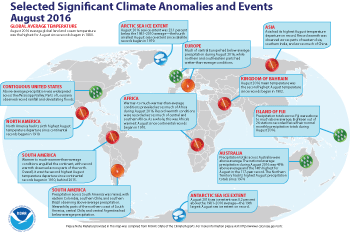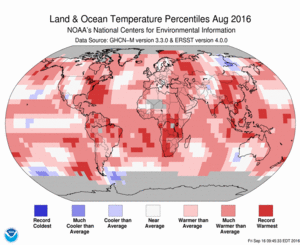Monthly Report Summary Information
The Monthly Report Summary Information is a synopsis of the collection of national and global summaries released each month.
Global Summary Information - August 2016
See Full Report
Note: With this report and data release, the National Centers for Environmental Information is transitioning to improved versions of its global land (GHCN-M version 3.3.0) and ocean (ERSST version 4.0.0) datasets. Please note that anomalies and ranks reflect the historical record according to these updated versions. Historical months and years may differ from what was reported in previous reports. For more, please visit the associated FAQ and supplemental information.
August marks 16 consecutive months of record-breaking heat for the globe
June–August and January–August were also record warm
Global highlights: August 2016
- The August temperature across global land and ocean surfaces was 1.66°F above the 20th century average of 60.1°F. This was the highest for August in the 1880–2016 record, surpassing the previous record set in 2015 by 0.09°F. August 2016 was the highest monthly temperature departure since April 2016 and tied with September 2015 as the eighth highest monthly temperature departure among all months (1,640) on record. Overall, 14 of the 15 highest monthly temperature departures in the record have occurred since February 2015, with January 2007 also among the 15 highest monthly temperature departures.
- The August globally averaged land surface temperature was 2.32°F above the 20th century average of 56.9°F. This value was the highest August land global temperature in the 1880–2016 record, exceeding the previous record set in 2015 by 0.34°F. This was also the highest monthly global land temperature departure from average since April 2016.
- The August globally averaged sea surface temperature was 1.39°F above the 20th century monthly average of 61.4°F—the second highest global ocean temperature for August in the 1880–2016 record, behind 2015 by 0.04°F. August 2016 tied with June 2016 as the 11th highest departure from average among all 1,640 months in the record.
- The August temperature for the lower troposphere (roughly the lowest 5 miles of the atmosphere) was the highest in the 1979–2016 record, at 0.85°F above the 1981–2010 average, as analyzed by the University of Alabama in Huntsville* (UAH) using UAH version 5.6. It was the third highest on record, at 0.65°F above the 1981–2010 average, as analyzed by Remote Sensing Systems* (RSS).
- The August temperature for the mid-troposphere (roughly 2 miles to 6 miles above the surface) was the highest for August in the 1979–2016 record, at 0.79°F above the 1981–2010 average, as analyzed by UAH. It tied with 2010 as the second highest on record, at 0.72°F above the 1981-2010 average, behind 1998, as analyzed by RSS. After removing the influence of temperatures above 6 miles in altitude, the University of Washington, using data analyzed by the UAH and RSS, calculated temperature departures from the 1981-2010 average to be 1.03°F (highest) and 0.92°F (second highest), respectively.
- The average Arctic sea ice extent for August was 650,000 square miles (23.1 percent) below the 1981–2010 average. This was the fourth smallest August extent since records began in 1979 and about 344,000 square miles larger than the record smallest August sea ice extent in 2012. According to an analysis by the National Snow and Ice Data Center based on data from NOAA and NASA, sea ice cover was below average for most regions of the Arctic with near-average sea ice cover for part of the Laptev Sea. August Arctic sea ice extent is decreasing at an average rate of 10.2 percent per decade.
- The Antarctic sea ice extent for August was 10,000 square miles (0.2 percent) above the 1981–2010 average. This was the 19th largest August Antarctic sea ice extent since records began in 1979. August Antarctic sea ice extent is increasing at an average rate of 0.8 percent per decade.
Global highlights: June–August 2016
- The June–August average temperature across global land and ocean surfaces was 1.60°F above the 20th century average of 60.1°F. This was the highest for June-August in the 1880–2016 record, surpassing the previous record set in 2015 by 0.07°F. June-August 2016 also marks the 10th highest three-month temperature departure from average for any three-month period on record. The 10 highest three-month temperature departures in the record have all occurred since August–October 2015, when a strong El Niño episode was in place in the tropical Pacific Ocean.
- The globally averaged land surface temperature for June–August 2016 was 2.18°F above the 20th century average of 56.9°F. This was the highest for June–August in the 1880–2016 record, surpassing the previous record of 2015 by 0.20°F.
- The June–August globally averaged sea surface temperature was 1.39°F above the 20th century average of 61.5°F the highest for June–August in the 1880–2016 record, surpassing the previous record of 2015 by 0.02°F. This was the 10th highest three-month departure from average for any three-month period on record. The 10 highest three-month temperature departures in the record have all occurred since July–September 2015, when strong El Niño conditions were in place in the tropical Pacific Ocean.
- The June-August temperature for the lower troposphere (roughly the lowest 5 miles of the atmosphere) was the second highest in the 1979–2016 record, at 0.77°F above the 1981–2010 average, as analyzed by the University of Alabama in Huntsville* (UAH) using version 5.6. It was the third highest on record, at 0.68°F above the 1981–2010 average, as analyzed by Remote Sensing Systems* (RSS).
- The June-August temperature for the mid-troposphere (roughly 2 miles to 6 miles above the surface) was the third highest for June-August in the 1979–2016 record, at 0.65°F above the 1981–2010 average, as analyzed by UAH. It was also the third highest on record, at 0.59°F above the 1981–2010 average, as analyzed by RSS. After removing the influence of temperatures above 6 miles in altitude, the University of Washington, using data analyzed by the UAH and RSS, calculated temperature departures from the 1981-2010 average to be 0.86°F and 0.77°F, respectively, both second highest in the record.
Global highlights: Year-to-date (January–August 2016)
- The year-to-date temperature across global land and ocean surfaces was 1.82°F above the 20th century average of 57.3°F. This was the highest for January–August in the 1880–2016 record, surpassing the previous record set in 2015 by 0.29°F.
- The year-to-date globally averaged land surface temperature was 2.92°F above the 20th century average of 48.1°F. This was the highest for January–August in the 1880–2016 record, exceeding the previous record of 2015 by 0.59°F.
- The year-to-date globally averaged sea surface temperature was 1.42°F above the 20th century average of 61.1°F. This was the highest for January–August in the 1880–2016 record, besting the previous record of 2015 by 0.20°F.
- The January-August temperature for the lower troposphere was the highest in the 1979–2016 record, at 1.12°F above the 1981–2010 average, as analyzed by the University of Alabama in Huntsville* (UAH) using version 5.6. It was also highest on record, at 0.99°F above the 1981–2010 average, as analyzed by Remote Sensing Systems* (RSS).
- The January-August temperature for the mid-troposphere was the second highest for January–August in the 1979–2016 record, at 0.92°F above the 1981–2010 average, as analyzed by UAH. It was also second highest on record, at 0.86°F above the 1981-2010 average, as analyzed by RSS. After removing the influence of temperatures above 6 miles in altitude, the University of Washington, using data analyzed by the UAH and RSS, calculated temperature departures from the 1981–2010 average to be 1.13°F (highest) and 1.06°F (second highest), respectively.
* Please note: the UAH and RSS referenced in this report are versions that have completed a research-to-operations (R2O) transition involving scientific, technical and administrative processes designed to ensure operational reliability. Both groups have new versions of their products at some stage of the R2O process and will be incorporated in this report when the R2O process is complete.
For extended analysis of global temperature and precipitation patterns, please see our full August report.
 NOAA's National Centers for Environmental Information
NOAA's National Centers for Environmental Information

